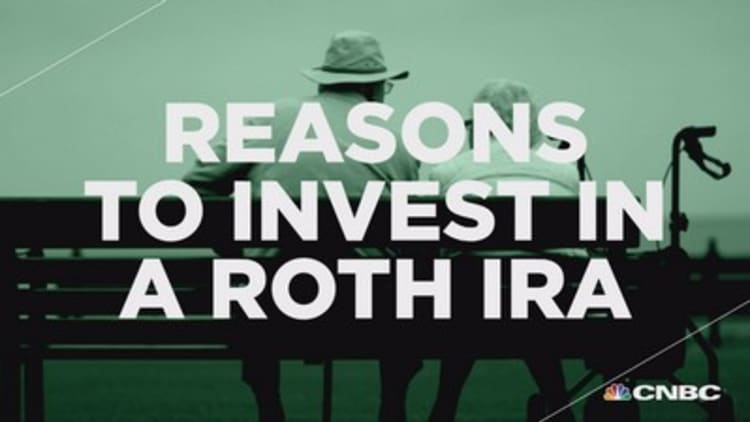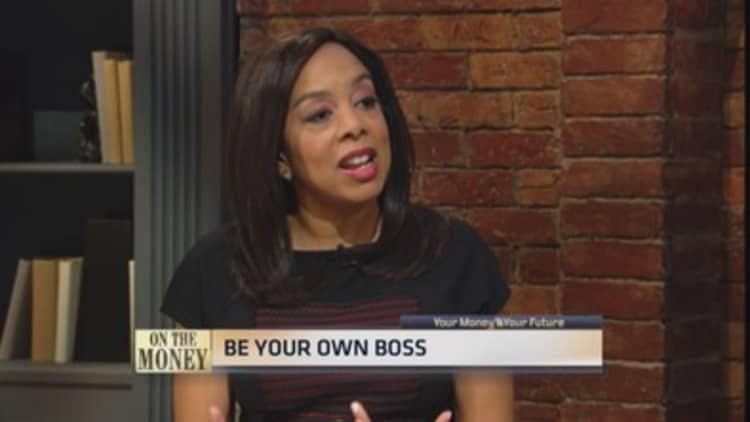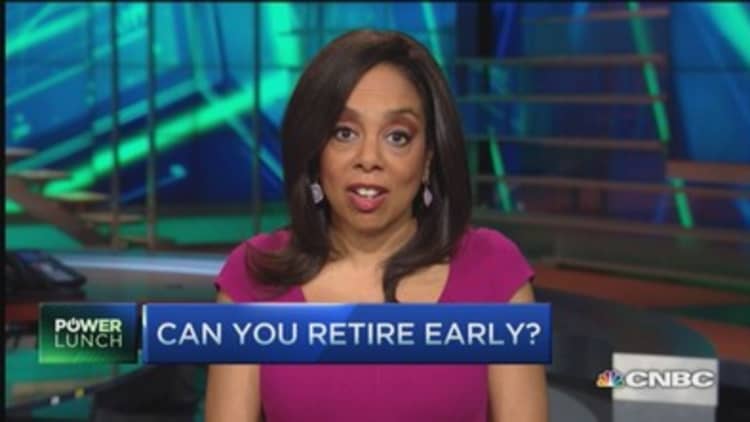


Fifty-three million Americans are now living the freelance life, and they have one very big thing in common: Without the backing of a full-time employer, the onus is on freelancers to handle their own retirement planning.
In all, about 34 percent of the nation's workforce is now freelance, according to a nationwide survey put out last summer by the Freelancers Union and Elance-oDesk, an online job marketplace. It's a percentage of the labor force that's been growing by roughly 1 million Americans per year over the past decade.
So how is this third of the U.S. workforce facing retirement? Not so well.
"I'm going to have to work until I drop dead," said Tom Egan, a graphic designer in his 50s living in Jersey City, New Jersey. "I'm way behind in retirement savings."
Egan mostly invests with mutual funds but has some individual stocks. He invests 60 percent of his assets in domestic equity, 15 percent each in international equity and global bonds, and about 10 percent in precious metals as an inflation hedge. He funds his accounts in the early spring, but only if he has any money left after doing his taxes. "I've missed quite a few years since 2000," he said.
Egan's situation is not out of the ordinary.
The nonprofit National Institute on Retirement Security released a study in March stating that nearly 40 million working-age households (about 45 percent of the U.S. total) have no retirement savings at all. And those that do have retirement savings don't have enough—the Federal Reserve's 2013 survey of consumer finances found that the mean holdings for families with retirement accounts was only $201,000.
Read More
Employing the 4 percent rule—a long-held conventional wisdom that withdrawing about 4 percent of a nest egg annually will allow a retiree's savings to last as long as they do—you'd only be supplementing Social Security with $8,040 per year on that amount. And the 4 percent rule itself has lately come under fire as lowballing the actual amount Americans will need to have a comfortable retirement.
"Freelancers really need to be smarter savers than the average American," said David Blanchett, head of retirement research at Morningstar Investment Management.
For one, freelancers don't get the employee match many corporations offer on 401(k) plans, doubling the amount of money workers can sock away for retirement. And for the freelancers who divert some of their savings to an emergency fund—which all freelancers should be doing—they are left with even less to put into a retirement account on an annual basis.
The biggest challenge freelancers face when it comes to retirement is the feast-or-famine nature of their income.Dan Lavoiedirector of strategy at the Freelancers Union
Nathan Schreiber, a Brooklyn-based illustrator and owner of a start-up children's education service called Science Ninjas, is only in his 30s, but saving for retirement is often on his mind. "I'm woefully unprepared for retirement and terrified about it," he said. He has a Roth IRA through TD Ameritrade linked to his savings account.
"When I do get a good job, I make a point of saving it." Like Egan, he looks at his finances at the end of each tax season before deciding if he can put money toward retirement that year. Schreiber owns some stock, including Toyota, which he buys and holds long-term, but most of his retirement assets are held in ETFs investing in broad NASDAQ and U.S. large-cap holdings.
"Technology is making it easier and easier to hire someone for, like, 10 minutes, even if they're halfway around the world," Schreiber said. "So getting decent long-term assignments is getting more difficult. I live frugally, have no debt and have some savings, but things are still tenuous. I think there's going to be a crisis for my generation; nobody's saving enough, and everybody's living longer. There's a brewing financial apocalypse." (Tweet this.)
Read MoreThese classic American brands reap 'ridiculous' returns
"The biggest challenge freelancers face when it comes to retirement is the feast-or-famine nature of their income," said Dan Lavoie, director of strategy at the Freelancers Union, a nonprofit that advocates for and supports independent workers. "One month you might be flush from a big project. But the next, you're looking for a new gig and prospecting. It's hard to know how much to put away or when you can afford to put it away. ... It's important to remember that every little bit helps," Lavoie explained.
There are three main types of retirement plans for the freelancer to consider:
Simplified Employee Pension (SEP)
These are easy-to-set-up ways to fund a traditional IRA, requiring only a one-page form, and they can be opened and funded right up until your tax-filing deadline. They are widely available at most banks and brokerages. You can contribute 25 percent of your net self-employment income, up to $53,000 annually. These plans can also work for small-business owners with a handful of employees, but they do not allow for Roth IRAs, wherein contributions are initially taxed but eventual withdrawals are tax-free.
Solo 401(k)
Also known as Individual 401(k)s, these allow $18,000 in annual contributions, plus 25 percent of net earnings from self-employment, up to $53,000 annually. Those 50 years or older looking to catch up on their retirement savings can put in an extra $6,000 annually. These plans can be funded on a pretax basis or post-tax as Roth contributions, and they allow for pre-retirement access through loans and hardship distributions. They must be set up by Dec. 31 of the preceding tax year.
Savings Incentive Match Plan for Employees (SIMPLE IRA)
This is for small-business owners, allowing them and their employees to contribute up to $12,500 annually (plus an extra $3,000 for those 50 or older) and either a 2 percent fixed contribution or a 3 percent matching contribution. SIMPLE plans also work for individuals, especially those who are considering eventually expanding their business with outside hires. As with the SEP and non-Roth 401(k), this plan offers upfront tax breaks and tax-deferred saving. You and/or your employees don't pay taxes until you withdraw money. The original self-employed retirement plans, Keogh plans (now sometimes referred to as HR-10 Plans) still exist but require substantial paperwork to set up and run and have generally fallen out of favor.
Rachael Parenta, a comedian in her 30s living in Brooklyn, does better than most. "I probably save a quarter of my income, but I don't do a good job of remembering to put it into my IRAs, so it sits in a savings account that accrues nearly no interest, which is one of the reasons I'm buying a house." Parenta and her husband are looking to purchase a two-family home as a means of supplementing their income and investing for the future. "'They aren't making any more land,' as Will Rogers and Lex Luthor said," she quipped.
Parenta has a regular IRA, as well as a Roth IRA and SEP. All three are invested in a range of mutual funds. She doesn't think she's saving enough, though. "I don't make a great amount of money, so it's hard to plan for retirement, pay expenses and maybe go to a bar now and again to live my life in the present moment with friends. How do you save for the future while also surviving in the present?"
Read MoreA real estate investment opportunity that may be ending
It's not uncommon for workers to accumulate several retirement plans over the years, such as a corporate-sponsored 401(k) from a former employer. If these plans have good investment options and low fees, there's no need to roll them over into a combined account.
But there's a catch: Any plan participant with $5,000 or more in a 401(k) plan can never be kicked out of the plan by a corporate sponsor, by law, but 401(k) account balances below $5,000 are not guaranteed placement in the plan—a plan sponsor could ultimately cut the participant a check (taxable) for the balance if the participant does not roll the money over into another 401(k) or IRA account.
Blanchett of Morningstar said more employers are allowing all former employees to stay in a 401(k) regardless of account balances, but former employees need to verify this policy exists. The advantage to staying in a 401(k) rather than rolling over to an IRA, if allowed, is that 401(k) plan account fees and underlying fund-management fees are typically lower than individual IRA fees—though 401(k) plans at very small companies may not be any more cost-attractive than an IRA. The negative to staying in a company 401(k) is that IRAs are more flexible when it comes to distribution policy, including emergency withdrawals.
Boston-based registered investment advisory firm The Colony Group vice chair Bob Glovsky recommends individual 401(k) plans as generally the best bet for independent contractors due to their flexibility and high savings limits.
A time to save, a time to pay off debt
Blanchett said that freelancers need to put more than the 12 percent recommended for 401(k) participants into a retirement account, but there is one big caveat: The focus on saving for retirement should not come before paying off high-interest debt.
Glovsky recommends putting 20 percent of freelance income toward either retirement savings or paying down outstanding debt. "The only debt people should have is mortgage debt," he said, adding, "Avoid all credit card debt. If you can't pay it off, you can't afford it."
The math on using credit cards for short-term financing while contributing to a retirement plan doesn't add up—Blanchett said it's "disastrous" for wealth creation.
"If you earn 10 percent on stocks and you're paying a 20 percent interest rate on credit cards, your effective rate of return is negative," Blanchett said, adding that the lack of a company match in a freelancer's retirement account is one more reason to think twice about saving for retirement before other financial needs.



